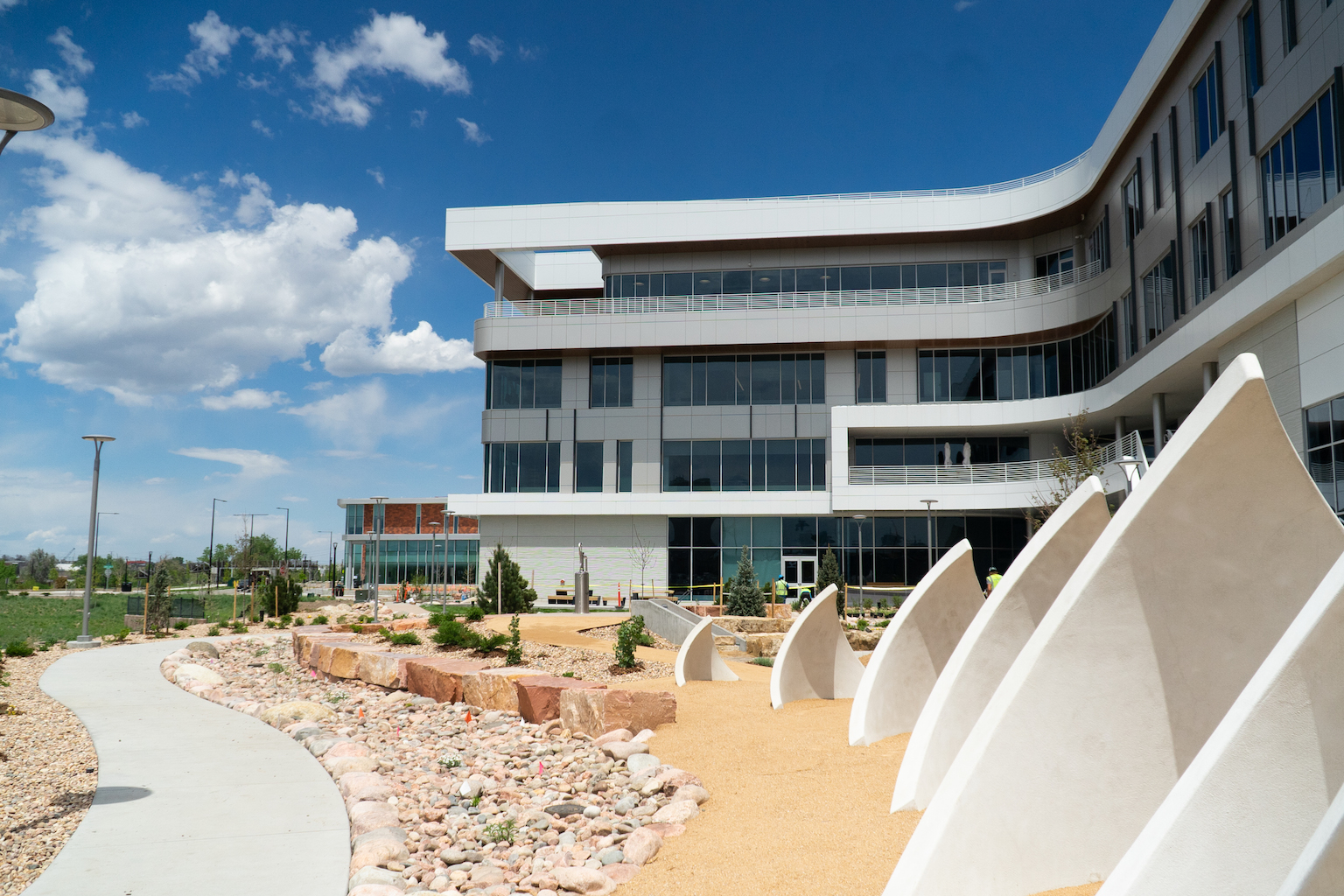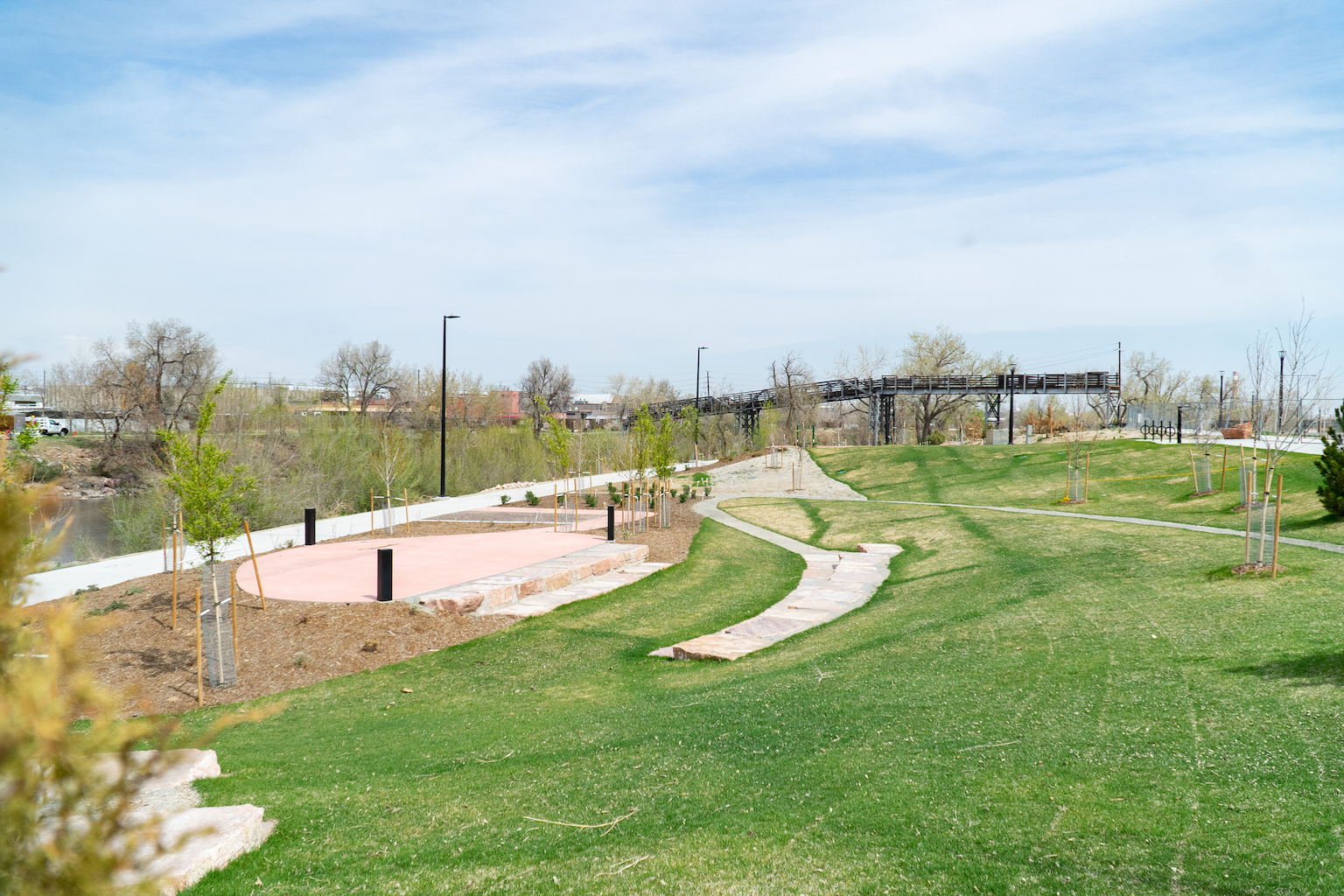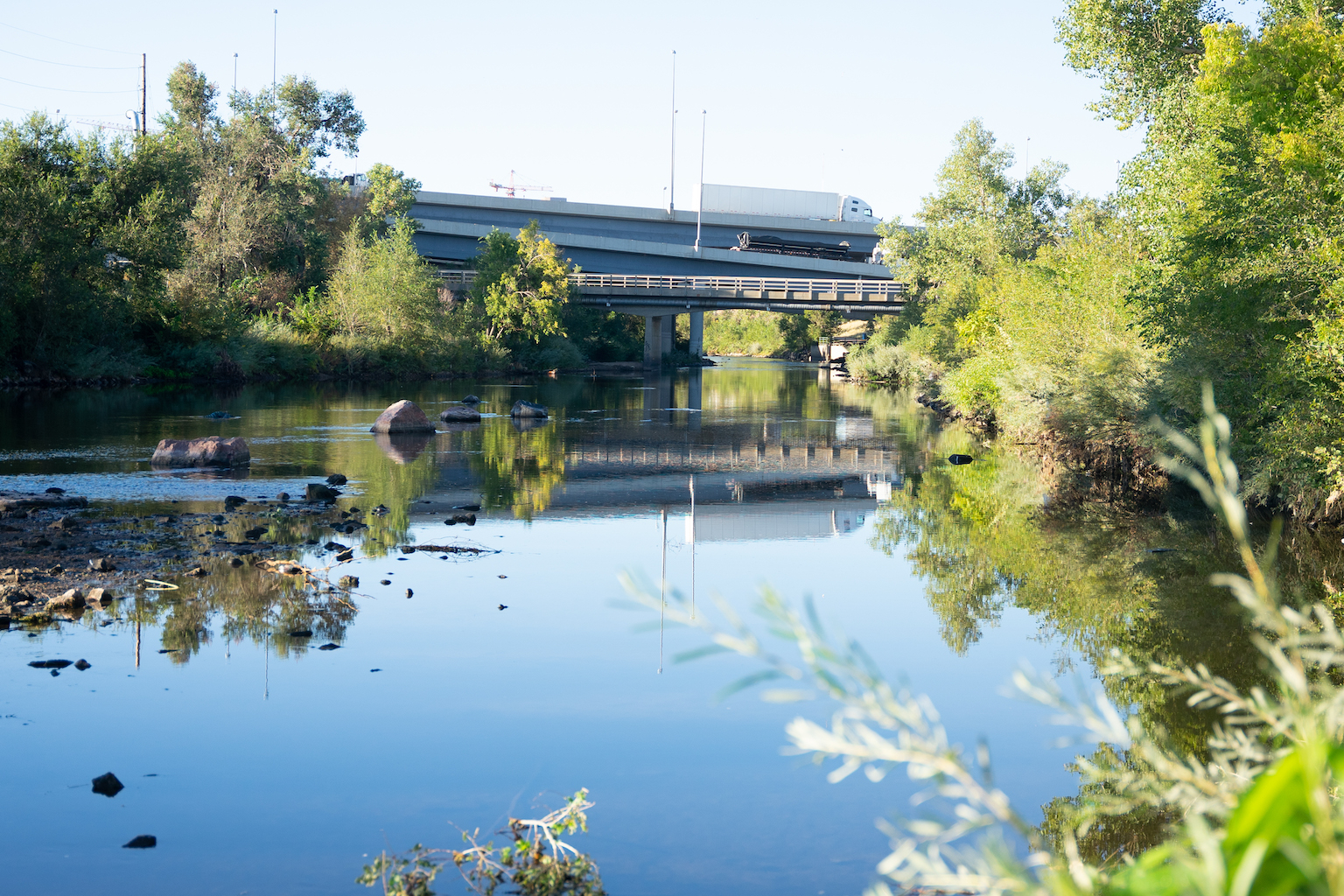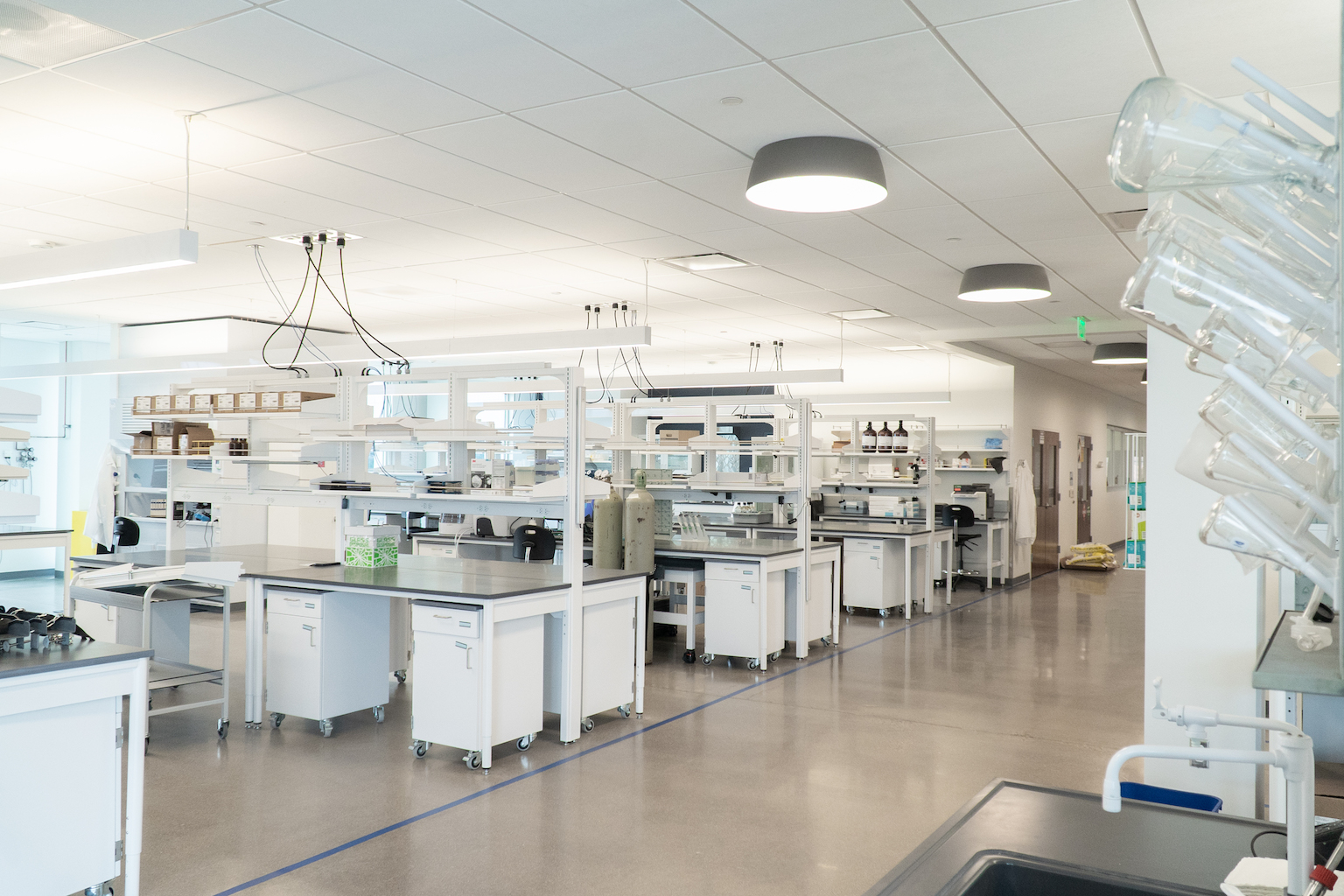Rivers run through it
June 8 celebration at CSU Spur, National Western Center focuses on water and the promise of partnerships story by Anthony Lane published June 7, 2023Along a stretch of the South Platte River once blocked by above-ground sewer pipes, visitors to the National Western Center in north Denver will soon find meandering trails, playground equipment, and an open-air amphitheater.
Nearby, in the Backyard at CSU Spur, outside the campus’s Hydro building, a model of Colorado’s four major watersheds, complete with a child-friendly pump to simulate rainfall on the Continental Divide, will give definition to a landscaped garden built to accommodate research, relaxation, and recreation.
And at Denver Water’s new water quality lab on Hydro’s third floor, state-of-the-art equipment, including a pair of metal-detecting spectrometers known affectionately as Betsi and Brandi, will soon be put to work monitoring the safety and quality of the utility’s water, both pre-treatment and after it is prepared for distribution to customers across the metropolitan area.
These three milestones in the redevelopment of the 250-acre National Western Center and establishment of the three-building CSU Spur campus will be on full display Thursday afternoon at an event celebrating progress at the site and recognizing what can be accomplished through wide-ranging and adaptable partnerships.
“The vision for CSU Spur has always been about bringing people and partners together to learn about water, food, and health, think about challenges, and explore potential solutions,” said Tony Frank, chancellor of the CSU System. “What makes this day so special is that we can now open the doors at CSU Spur, see the connection to the river, and recognize that the work we have been doing is making a difference.”

Nikki Pike’s Crescendo is among the art installations awaiting visitors to the Backyard at CSU Spur.
Thursday’s event from 4-7 p.m. at the Riverfront Open Space and the Backyard at CSU Spur will begin with remarks from Denver Mayor Michael Hancock.
The new open space on the South Platte River demonstrates how opportunities can arise out of challenges. Redevelopment plans at the National Western Center originally called for the burial of two six-foot sewer pipes that ran above ground next to the river to open access to the riverfront adjacent to the campus. Then partners started wondering: what if the steady warmth of water running through those pipes could be used to heat and cool buildings at the National Western Center?
The resulting sewer-heat recovery system, the largest of its kind in North America, now meets 90% of the heating and cooling needs of the three CSU Spur buildings and one additional building at the center, and it will do the same for at least two additional buildings when the redevelopment project is complete.
National Western Center Authority CEO Brad Buchanan, a champion for the sewer-heat recovery system and for restoration efforts along the South Platte River, explained the significance of Thursday’s event. “By creating a new riverfront open space that connects people to the natural environment and encourages activity and play, the National Western Center will become an anchor point that strengthens connections between Globeville and Elyria-Swansea and will create a much-needed recreational amenity for North Denver residents,” he said.


Visitors to the new Riverfront Open Space at the National Western Center will be able to approach the South Platte River along a stretch of water where access was once blocked by above-ground sewer pipes.
From the windows of Denver Water’s new lab on Hydro’s third floor, the restored riverfront is a splash of green in a landscape that takes in the river, the city, and the peaks of the Front Range, still snowcapped in early June. The lab, which combined with office space occupies 26,000 square-feet, replaces an 8,700 square-foot facility that was built more than 60 years ago on the grounds of the Marston Water Treatment Plant in southwest Denver.
“This is where Denver Water’s water quality experts will perform nearly 200,000 tests every year to ensure our water is always at the highest standard,” said Tom Roode, the utility’s chief operations and maintenance officer.
While these experts used to work in a facility largely hidden from the public, they will soon be working in a space where windows allow Hydro visitors to watch sample preparation and other tasks. In time, according to Alfonso Gonzales, the lab’s manager, Denver Water will find other ways to engage the public and connect them with a process that assesses the quality of water that is collected in the mountains and distributed to their taps.
“I’m excited for when we get the educational component going to let youth know this is a viable career path,” Gonzales said.
First, the lab will complete the process for certification over the next two to four weeks and then become operational. Lab technicians will adapt to new workflows as they prepare to conduct multiple tests on the 200 or more water samples arriving at the lab each day.
The lab is divided into sections, with high-tech instruments appropriate to each sensing even the tiniest quantities of trace chemicals, elements, and organic compounds. The Colorado Department of Health and Environment certifies and monitors Denver Water and other water providers, overseeing compliance with state and federal guidelines meant to shield the public from exposure to dozens of contaminants, including microbiological impurities.
Denver Water does its microbiological testing at another lab. At Hydro, water technicians will test water samples for even trace amounts of regulated chemicals. Betsi and Brandi are inductively coupled plasma mass spectrometers, tasked to examine treated and raw water for any of 28 metals ranging from boron and beryllium to arsenic.
Beyond regulations focused on safety, Denver Water technicians also monitor for compounds that can give rise to unwanted tastes and smells. These include the natural compounds geosmin and MIB, which are associated with the earthy, musty smell many people detect outdoors after a rainstorm.
The visibility of Denver Water’s new lab is already making a difference in connecting with the public and reaching potential employees. Kim Unger, a senior communications specialist at Denver Water, recalled how a colleague had a conversation at the Hydro opening celebration with a soon-to-be college graduate who now has started in a position with Denver Water.
“This just puts us on the map,” she said.

After the certification process is completed in coming weeks, Denver Water’s new water quality lab on Hydro’s third floor will accommodate up to 200,000 tests each year aimed at ensuring the safety and quality of water distributed to customers across the metropolitan area.
The idea of exposing students and learners of all ages to new academic and career possibilities was among the major motivators for the CSU System, with support from Colorado lawmakers and partners, to pursue construction of the CSU Spur campus. Spur started welcoming visitors with the Jan. 7, 2022, opening of the health-themed Vida building. The food-focused Terra building opened in June, followed by Hydro in January this year.
After a year-and-a-half of regular opening celebrations, and close to a decade of planning, Thursday’s event marks a significant transition at CSU Spur.
“It’s nice to put the last piece in place and say the physical space is complete,” said Jocelyn Hittle, the CSU System’s associate vice chancellor for CSU Spur and special projects.
Now the focus at CSU Spur is on deepening opportunities for research, education, and engaging with students, families, and others who visit the campus. The Backyard, which invites visitors to linger, explore, and connect, is a central part of that vision.
It’s also an active research space. Two CSU researchers, working with a graduate student, are preparing to launch a four-year study, funded by the Mile High Flood District and City and County of Denver, to test how well plants grow in two test plots that will be irrigated with stormwater collected at the National Western Center.
The project is the most recent collaboration coming out of the two researchers’ ongoing efforts at CSU Spur. Sybil Sharvelle, a CSU professor of civil and environmental engineering, is director of the Water Technology Acceleration Platform, or Water TAP, which aims to assess the quality of water from different sources and then try out technologies and techniques to treat each for differing “fit-for-purpose” uses. Jennifer Bousselot, an assistant professor of horticulture and landscape architecture, oversees two research spaces at Spur – one pairing agriculture with photovoltaics – assessing the potential for food and other plant production on urban rooftops.
Creating opportunities for this kind of interdisciplinary research is central to CSU Spur’s mission and development of Hydro’s new Backyard.
“Enabling collaborative research like this in a beautiful, public-facing space is really what it’s all about,” Hittle said.
About CSU Spur
CSU Spur is a new, free learning destination open year-round in Denver, focused on engaging K-12 students, families, and visitors around food, water, and health. CSU Spur showcases the work of the CSU System campuses: CSU, CSU Pueblo, and CSU Global, while advancing knowledge on topics in food, water, health and sustainability. Spur is built upon the land-grant mission of access to education. To inspire lifelong learners to engage in important world issues, CSU Spur brings together scientists at work with youth and families, showcasing career paths, while creating a space and place for collaboration across disciplines. The CSU Spur campus provides immersive learning experiences and cutting-edge research across three buildings: Vida, Terra, and Hydro. Learn more at CSUSpur.org.